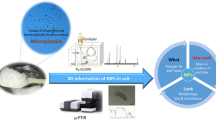Abstract
In recent years, the development of reliable methods for the quantitation of microplastics in different samples, including evaluating the particles’ adverse effects in the marine environment, has become a great concern. Because polyolefins are the most prevalent type of polymer in personal-care products containing microplastics, this study presents a novel approach for their quantitation. The method is suitable for aqueous and hydrocarbon-based products, and includes a rapid sample clean-up involving twofold density separation and a subsequent quantitation with high-temperature gel-permeation chromatography. In contrast with previous procedures, both errors caused by weighing after insufficient separation of plastics and matrix and time-consuming visual sorting are avoided. In addition to reliable quantitative results, in this investigation a comprehensive characterization of the polymer particles isolated from the product matrix, covering size, shape, molecular weight distribution and stabilization, is provided. Results for seven different personal-care products are presented. Recoveries of this method were in the range of 92–96 %.




Similar content being viewed by others
References
Barnes DK, Galgani F, Thompson RC, Barlaz M (2009) Accumulation and fragmentation of plastic debris in global environments. Phil Trans R Soc B Biol Sci 364(1526):1985–1998
Cole M, Lindeque P, Halsband C, Galloway TS (2011) Microplastics as contaminants in the marine environment: a review. Mar Pollut Bull 62(12):2588–2597
Gregory MR (1996) Plastic ‘scrubbers’ in hand cleansers: a further (and minor) source for marine pollution identified. Mar Pollut Bull 32(12):867–871
Fendall LS, Sewell MA (2009) Contributing to marine pollution by washing your face: microplastics in facial cleansers. Mar Pollut Bull 58(8):1225–1228
Zitko V, Hanlon M (1991) Another source of pollution by plastics: skin cleaners with plastic scrubbers. Mar Pollut Bull 22(1):41–42
Moore CJ (2008) Synthetic polymers in the marine environment: a rapidly increasing, long-term threat. Environ Res 108(2):131–139
Teuten EL, Rowland SJ, Galloway TS, Thompson RC (2007) Potential for plastics to transport hydrophobic contaminants. Environ Sci Technol 41(22):7759–7764
Hidalgo-Ruz V, Gutow L, Thompson RC, Thiel M (2012) Microplastics in the marine environment: a review of the methods used for identification and quantification. Environ Sci Technol 46(6):3060–3075
Imhof HK, Schmid J, Niessner R, Ivleva NP, Laforsch C (2012) A novel, highly efficient method for the separation and quantification of plastic particles in sediments of aquatic environments. Limnol Oceanogr Methods 10:524–537
Nuelle M, Dekiff JH, Remy D, Fries E (2014) A new analytical approach for monitoring microplastics in marine sediments. Environ Pollut 184:161–169
Fries E, Dekiff JH, Willmeyer J, Nuelle M, Ebert M, Remy D (2013) Identification of polymer types and additives in marine microplastic particles using pyrolysis-GC/MS and scanning electron microscopy. Environ Sci Process Impacts 15(10):1949
International campaign against microbeads in cosmetics: beat the microbead. http://beatthemicrobead.org/
Stiftinger M, Buchberger W, Klampfl CW (2013) Miniaturized method for the quantitation of stabilisers in microtome cuts of polymer materials by HPLC with UV, MS or MS2 detection. Anal Bioanal Chem 405(10):3177–3184
Beißmann S, Stiftinger M, Grabmayer K, Wallner G, Nitsche D, Buchberger W (2013) Monitoring the degradation of stabilization systems in polypropylene during accelerated aging tests by liquid chromatography combined with atmospheric pressure chemical ionization mass spectrometry. Polym Degrad Stab 98(9):1655–1661
Zweifel H, Maier RD, Schiller M (2008) Plastics additives handbook, 6th edn. Hanser, München
Author information
Authors and Affiliations
Corresponding author
Rights and permissions
About this article
Cite this article
Hintersteiner, I., Himmelsbach, M. & Buchberger, W.W. Characterization and quantitation of polyolefin microplastics in personal-care products using high-temperature gel-permeation chromatography. Anal Bioanal Chem 407, 1253–1259 (2015). https://doi.org/10.1007/s00216-014-8318-2
Received:
Revised:
Accepted:
Published:
Issue Date:
DOI: https://doi.org/10.1007/s00216-014-8318-2




